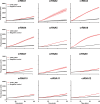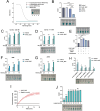An ELISA-like sensitive and visual detection system targeting Yersinia pestis based on CRISPR/Cas12a and DNAzyme
- PMID: 40704803
- PMCID: PMC12345247
- DOI: 10.1128/jcm.00274-25
An ELISA-like sensitive and visual detection system targeting Yersinia pestis based on CRISPR/Cas12a and DNAzyme
Abstract
Yersinia pestis is the causative agent of plague, a human disease with potentially devastating consequences. Here, we developed an enzyme-linked immunosorbent assay-like visual detection method based on clustered regularly interspaced short palindromic repeats (CRISPR) detection and DNAzyme for the cost-effective and highly sensitive detection of Y. pestis. A novel specific gene sequence (CH57_3927) was screened for the detection target of Y. pestis. The recombinase-aided amplification (RAA) assay, CRISPR/Cas12a detection assay, and G-quadruplex (G4) DNAzyme-based color development assay were separately established and optimized. These three optimized assays were integrated into an advanced ELISA-like visual detection method-RAA-CRISPR/Cas12a-DNAzyme (RCCD)-by further optimization of their components to improve the compatibility between them. The amplified target sequence binds to crRNA and activates the Cas12a nucleases for trans-cleave G4. As a result, the cleaved G4 is unable to bind with hemin to exert peroxidase activity, thus impeding the catalysis of the 2,2'-azino-bis(3-ethylbenzothiazoline-6-sulfonic acid) (ABTS2-) colorimetric reaction. Consequently, negative samples exhibit a dark green coloration, while the positive products appear nearly colorless, facilitating visual differentiation with the naked eye. In addition, the RCCD detection platform effectively distinguished Y. pestis from all other closely related species, with a detection limit of 1 copy/reaction. Evaluated using Y. pestis DNA-spiked blood samples and uninfected samples, both sensitivity and specificity were 100%. The method shows significant potential for detecting targets in clinical samples and is well-suited for use in resource-limited environments. It offers advantages such as visual detection, batch detection, and low cost.IMPORTANCEWe utilized Mauve software to screen Yersinia pestis specific genes and integrated CRISPR-Cas12a, RAA amplification, and G-quadruplex DNAzyme technology to establish an advanced ELISA-like visual detection method. The visual detection method offers a more cost-effective alternative compared to the conventional CRISPR detection method that relies on fluorescence-labeled ssDNA reporter or lateral flow (LF) test strips. With only one thermostatic device required, it enhances the convenience of rapid on-site screening of Y. pestis outbreaks, providing effective support for plague detection, prevention, and control within primary medical and health institutions.
Keywords: CRISPR-Cas12a; G-quadruplex; Yersinia pestis; diagnosis; nucleic acid detection; recombinase-aided amplification.
Conflict of interest statement
The authors declare no conflict of interest.
Figures






Similar articles
-
A naked-eye biosensing system based on one-pot RPA-CRISPR/Cas12a driver G4-hemin self-assembly for Mycobacterium tuberculosis.Front Chem. 2025 Aug 7;13:1631086. doi: 10.3389/fchem.2025.1631086. eCollection 2025. Front Chem. 2025. PMID: 40851838 Free PMC article.
-
[One-Step Detection of Human Influenza B Virus Through Recombinase Polymerase Amplification and CRISPR/Cas12a Protein].Sichuan Da Xue Xue Bao Yi Xue Ban. 2025 Mar 20;56(2):549-555. doi: 10.12182/20250360105. Sichuan Da Xue Xue Bao Yi Xue Ban. 2025. PMID: 40599263 Free PMC article. Chinese.
-
Establishment of a RAA-CRISPR Cas12a based diagnostic method for peste des petits ruminants virus N gene and M gene.J Virol Methods. 2024 Sep;329:114971. doi: 10.1016/j.jviromet.2024.114971. Epub 2024 Jun 12. J Virol Methods. 2024. PMID: 38876255
-
The effect of sample site and collection procedure on identification of SARS-CoV-2 infection.Cochrane Database Syst Rev. 2024 Dec 16;12(12):CD014780. doi: 10.1002/14651858.CD014780. Cochrane Database Syst Rev. 2024. PMID: 39679851 Free PMC article.
-
Viral detection using Clustered Regularly Interspaced Short Palindromic Repeats/CRISPR-associated protein and Argonaute nucleases.Clin Chim Acta. 2025 Aug 7;578:120526. doi: 10.1016/j.cca.2025.120526. Online ahead of print. Clin Chim Acta. 2025. PMID: 40763823 Review.
References
-
- Human plague: review of regional morbidity and mortality, 2004-2009. 2009. Wkly Epidemiol Rec 6:40–45. - PubMed
-
- Bertherata E. 2016. Plague around the world, 2010–2015. Wkly Epidemiol Rec 91:89–93.
-
- World Health Organization . 2019. Plague around the world in 2019. Wkly Epidemiol Rec 94:289–292.
-
- World Health Organization . 2022. Plague. World Health Organization. https://www.who.int/en/news-room/fact-sheets/detail/plague.
MeSH terms
Substances
Grants and funding
LinkOut - more resources
Full Text Sources
Medical
Research Materials
Miscellaneous

